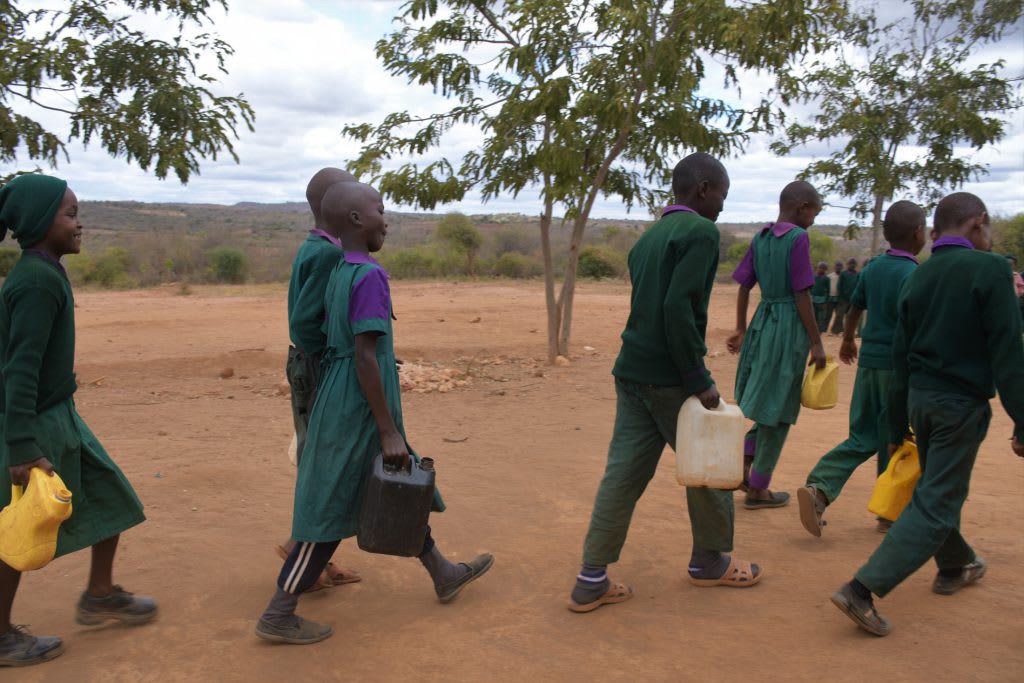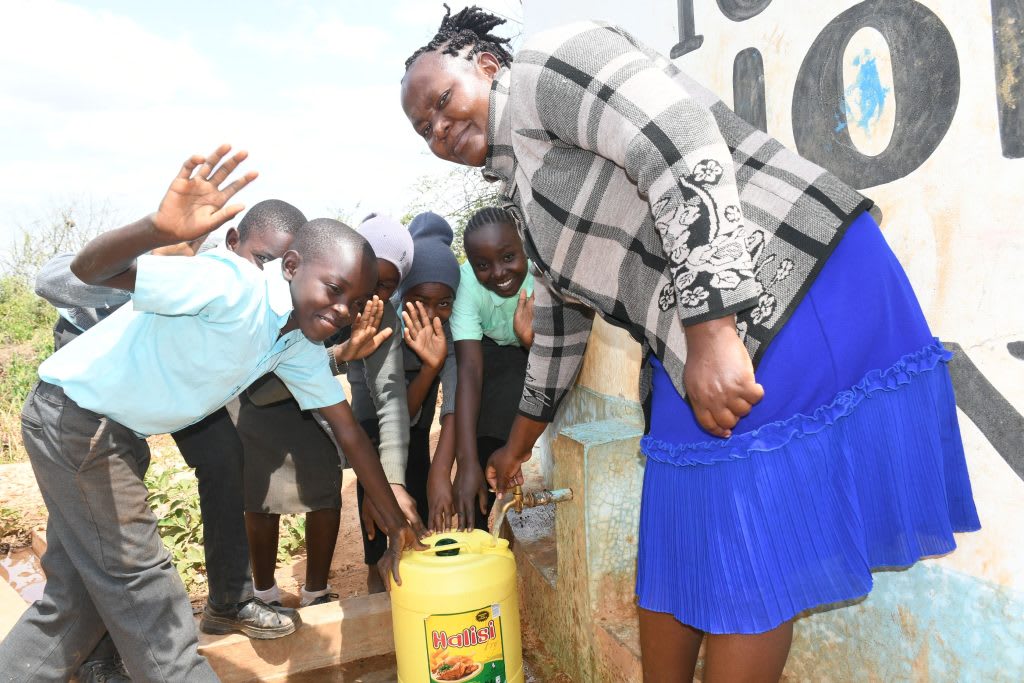The 122 students and 13 staff at Ngaaka Primary School struggle to access sufficient water to meet their daily needs. Students spend much of their time and energy searching for and collecting water, leaving them little energy to focus on learning.
"Ngaaka Primary School is located in the rural and semi-arid Kitui County [which] is prone to poor precipitation and long drought periods; thus, it suffers from inadequate water availability. The pupils have to carry water to school every morning, not to mention the load of books in their school bags. The water points are located far away from the school, which affects the school's daily schedule. They [also] help their parents most evenings and weekends to fetch water from Kaundu River, [which] is located about 7km (over 4 miles) away from most residents," said field officer Alex Koech.

"Pupils carry water in unclean containers that are mostly acquired from contaminated scoop holes (a representative photo of students collecting water from a river scoop hole below). During peak drought periods, the scoop holes dry up, and pupils, as well as the parents, are unable to avail water in the school. The water brought by the pupils and parents is also not enough to satisfy the entire population's needs, such as drinking, cooking, or conducting hygiene and sanitation," Alex continued.

"Every evening, I have to help my parents draw water at the distant scoop hole. I get so tired because I still walk back home from school. I have little time and energy to play with friends. Sometimes, like last month, I developed a stomach ache and had to go home to look for treatment. The stomach aches normally occur because we drink unclean water," said 12-year-old Ndanu M. (seen below).

The water students and their families manage to collect is emptied into a small rain tank on the school campus, but it runs dry quickly, leaving the students, teachers, and school staff without water to drink, cook or take care of sanitation tasks. It is a distressing situation for everyone.

Understandably, students are exhausted, but their energy is not the only resource consumed by the water crisis. Relying on water that is so far away and contaminated is also having a negative impact on the students' health. Students often have water-related illnesses that make them miss even more valuable time in school. And being ill usually means they need medical treatment and medications, which also consumes much of their family's needed resources.
"Since the water is acquired from mostly contaminated sources and carried in unclean containers, the pupils often complain of water-related infections such as typhoid, amoeba, and dysentery," said Alex.
"[The] lack of water in our school has made life so difficult because there are times that there is no water in the school, which makes it difficult to prepare meals or drink water. These pupils are very young, and making them concentrate in class on empty stomachs and burning throats is hard," said 43-year-old teacher Agnes Munyoki (seen below).

She continued, "This has led to poor academic performance since most of them abscond school altogether. Those who bear with the adverse situation cannot get proper grades that put them in better secondary schools. When the rainwater tank will be implemented, we will have enough water within the school compound, which will enable us [to] achieve better academic performance and student retention."
"I believe that the set up of a catchment tank in our school will enable me [to] get more time to play with my friends and improve my studies," concluded Ndanu.
Installing the very large rain tank with a guttering system will allow the school to collect a large amount of water during the short rainy periods to sustain them through the dry season. This will relieve the students like Ndanu and allow them to focus on learning. Teachers like Agnes will be able to use their time educating them so students can have a brighter future instead of suffering without drinking water or the need to consume the water they know will make them ill.
Water at schools is unique, which is why we need unique solutions.
The Proposed Solution, Determined Together...
At The Water Project, everyone has a part in conversations and solutions. We operate in transparency, believing it benefits everyone. We expect reliability from one another as well as our water solutions. Everyone involved makes this possible through hard work and dedication.
In a joint discovery process, community members determine their most advantageous water solution alongside our technical experts. Read more specifics about this solution on the What We're Building tab of this project page. Then, community members lend their support by collecting needed construction materials (sometimes for months ahead of time!), providing labor alongside our artisans, sheltering and feeding the builders, and supplying additional resources.
Water Access for Everyone
This water project is one piece in a large puzzle. In Kenya, Sierra Leone, and Uganda, we're working toward complete coverage of reliable, maintained water sources that guarantee public access now and in the future within a 30-minute round trip for each community, household, school, and health center. One day, we hope to report that this has been achieved!
Training on Health, Hygiene & More
With the community's input, we've identified topics where training will increase positive health outcomes at personal, household, and community levels. We'll coordinate with them to find the best training date. Some examples of what we train communities on are:
- Improved hygiene, health, and sanitation habits
- Safe water handling, storage & treatment
- Disease prevention and proper handwashing
- Income-generation
- Community leadership, governance, & election of a water committee
- Operation and maintenance of the water point
Handwashing Stations
Alongside each water source in Southeast Kenya schools, we also provide three new handwashing stations fitted with three taps each, allowing nine students to wash their hands at once. These will allow everyone at the school to wash their hands without running water. Handwashing is so important to help prevent future water-related illnesses in the school community.
The student health club will maintain the stations, fill them with water, and supply them with soap (which we will teach the school community how to make during the training!).





 Rainwater Catchment
Rainwater Catchment
 Rehabilitation Project
Rehabilitation Project



























